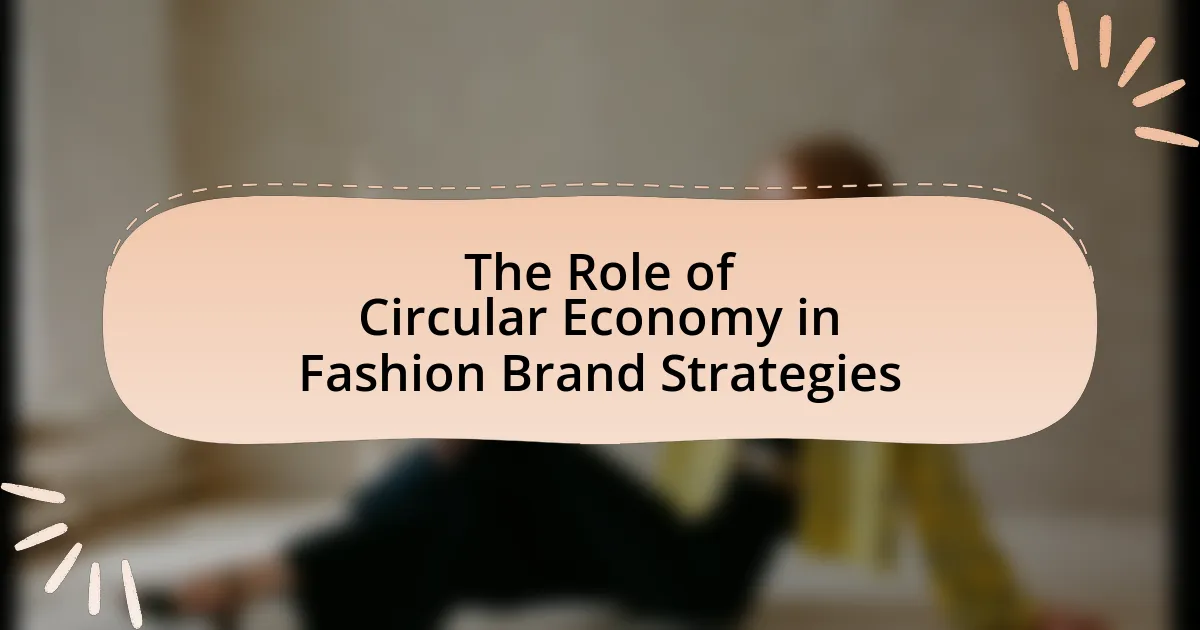Sustainable fashion is increasingly recognized for its economic benefits to brands, including cost savings, enhanced brand loyalty, and access to new markets. By implementing sustainable practices, brands can reduce operational expenses and attract environmentally conscious consumers willing to pay a premium for ethical products. The article explores how sustainable fashion influences brand profitability, consumer purchasing decisions, and market growth, while also addressing the risks of neglecting sustainability. Additionally, it outlines effective strategies for brands to transition to sustainable practices and maximize economic advantages, emphasizing the importance of collaboration with sustainable suppliers and transparent marketing approaches.

What are the Economic Benefits of Sustainable Fashion for Brands?
Sustainable fashion provides significant economic benefits for brands, including cost savings, enhanced brand loyalty, and access to new markets. By adopting sustainable practices, brands can reduce production costs through efficient resource management and waste reduction, which can lead to a decrease in operational expenses. For instance, a study by McKinsey & Company found that companies implementing sustainable practices can save up to 20% on their supply chain costs.
Additionally, sustainable fashion attracts environmentally conscious consumers, fostering brand loyalty and increasing customer retention. Research from Nielsen indicates that 66% of global consumers are willing to pay more for sustainable brands, highlighting the potential for increased sales and market share. Furthermore, brands that prioritize sustainability can tap into emerging markets focused on eco-friendly products, expanding their customer base and driving revenue growth.
Overall, the economic advantages of sustainable fashion for brands are evident through cost efficiencies, enhanced customer loyalty, and new market opportunities.
How does sustainable fashion impact brand profitability?
Sustainable fashion positively impacts brand profitability by enhancing consumer loyalty and attracting a growing market segment that prioritizes ethical practices. Brands that adopt sustainable practices often experience increased sales, as 66% of global consumers are willing to pay more for sustainable brands, according to a Nielsen report. Additionally, sustainable fashion can lead to cost savings through efficient resource management and waste reduction, further improving profit margins. Companies like Patagonia have demonstrated that commitment to sustainability can result in strong brand loyalty and repeat purchases, ultimately driving profitability.
What cost savings can brands achieve through sustainable practices?
Brands can achieve significant cost savings through sustainable practices by reducing resource consumption and waste. For instance, implementing energy-efficient technologies can lower utility bills, with companies like Walmart reporting savings of over $1 billion annually from energy efficiency initiatives. Additionally, sustainable sourcing of materials often leads to lower costs in the long term, as seen in the case of Unilever, which saved €600 million by using sustainable agricultural practices. Furthermore, reducing waste through recycling and circular economy strategies can minimize disposal costs, as evidenced by the Ellen MacArthur Foundation’s report indicating that transitioning to a circular economy could generate $1 trillion in economic benefits. These examples illustrate that sustainable practices not only enhance brand reputation but also lead to substantial financial savings.
How does sustainable fashion influence consumer purchasing decisions?
Sustainable fashion significantly influences consumer purchasing decisions by increasing the likelihood of consumers choosing brands that prioritize environmental and ethical practices. Research indicates that 66% of global consumers are willing to pay more for sustainable brands, reflecting a growing preference for products that align with personal values regarding sustainability. Additionally, a study published in the Journal of Cleaner Production found that consumers are more likely to engage with brands that demonstrate transparency in their supply chains and sustainable practices, further driving purchasing behavior. This trend highlights the economic benefits for brands that adopt sustainable practices, as they can attract a loyal customer base willing to invest in ethical products.
Why is sustainable fashion becoming a competitive advantage?
Sustainable fashion is becoming a competitive advantage because it aligns with consumer demand for ethical and environmentally friendly products. Brands that adopt sustainable practices can differentiate themselves in a crowded market, attracting a growing segment of consumers who prioritize sustainability. According to a 2021 McKinsey report, 67% of consumers consider sustainability when making a purchase, indicating a significant shift in purchasing behavior. This consumer preference not only enhances brand loyalty but also allows companies to command premium pricing, thereby increasing profitability. Additionally, sustainable practices can lead to cost savings through efficient resource management and waste reduction, further solidifying a brand’s competitive edge in the fashion industry.
What role does brand reputation play in economic benefits?
Brand reputation significantly influences economic benefits by enhancing customer loyalty and driving sales. A strong brand reputation fosters trust, leading consumers to prefer purchasing from reputable brands over lesser-known competitors. For instance, a study by Nielsen found that 66% of global consumers are willing to pay more for sustainable brands, indicating that positive brand reputation can directly translate into increased revenue. Furthermore, companies with strong reputations often experience lower marketing costs, as word-of-mouth and customer referrals become more effective, thereby improving overall profitability.
How can sustainable fashion enhance customer loyalty?
Sustainable fashion enhances customer loyalty by aligning brand values with consumer ethics, fostering a deeper emotional connection. Brands that prioritize sustainability often attract customers who are environmentally conscious, leading to repeat purchases; for instance, a 2021 study by McKinsey & Company found that 67% of consumers consider sustainability when making a purchase decision. This alignment not only increases customer retention but also encourages word-of-mouth referrals, as satisfied customers share their positive experiences with like-minded individuals.
What are the long-term economic impacts of adopting sustainable fashion?
The long-term economic impacts of adopting sustainable fashion include reduced operational costs, increased consumer loyalty, and enhanced brand reputation. Sustainable practices often lead to lower resource consumption and waste management costs, which can significantly decrease overall expenses for brands. For instance, a study by McKinsey & Company found that companies implementing sustainable practices can save up to 20% on operational costs over time. Additionally, consumers are increasingly favoring brands that prioritize sustainability, leading to higher customer retention rates and potentially increased sales. According to a Nielsen report, 66% of global consumers are willing to pay more for sustainable brands, indicating a strong market demand. Furthermore, sustainable fashion can enhance brand reputation, attracting investors and partners who prioritize corporate social responsibility, ultimately contributing to long-term financial stability and growth.
How does sustainable fashion contribute to market growth?
Sustainable fashion contributes to market growth by attracting a growing consumer base that prioritizes ethical and environmentally friendly practices. This shift in consumer behavior is evidenced by a 2021 McKinsey report indicating that 67% of consumers consider sustainability when making a purchase, leading brands to adapt their strategies to meet this demand. Consequently, companies that embrace sustainable practices often experience increased sales, enhanced brand loyalty, and improved market positioning, ultimately driving economic growth within the fashion industry.
What are the risks of not adopting sustainable practices?
The risks of not adopting sustainable practices include environmental degradation, financial loss, and reputational damage. Environmental degradation occurs as unsustainable practices contribute to pollution, resource depletion, and climate change, which can lead to severe ecological consequences. Financial loss is evident as consumers increasingly prefer brands that demonstrate sustainability; failure to adapt can result in decreased sales and market share. Reputational damage arises when brands are associated with harmful practices, leading to negative public perception and loss of customer loyalty. According to a 2021 survey by McKinsey, 67% of consumers consider sustainability when making purchasing decisions, highlighting the financial implications of neglecting sustainable practices.
How can brands effectively transition to sustainable fashion?
Brands can effectively transition to sustainable fashion by adopting eco-friendly materials, implementing ethical production practices, and engaging in transparent supply chain management. Utilizing organic cotton, recycled polyester, and other sustainable fabrics reduces environmental impact and appeals to eco-conscious consumers. Ethical production practices, such as fair labor conditions and reduced waste, enhance brand reputation and customer loyalty. Furthermore, transparent supply chain management fosters trust and accountability, as consumers increasingly demand information about the origins and sustainability of their products. According to a 2021 McKinsey report, brands that prioritize sustainability can see a 10-15% increase in sales, demonstrating the economic benefits of this transition.
What strategies can brands implement to maximize economic benefits?
Brands can maximize economic benefits by adopting sustainable practices, which not only reduce costs but also enhance brand loyalty and market competitiveness. Implementing strategies such as using eco-friendly materials can lower production costs in the long run, as sustainable materials often lead to reduced waste and energy consumption. For instance, a study by McKinsey & Company found that companies embracing sustainability can achieve up to 20% cost savings through improved resource efficiency. Additionally, brands that communicate their commitment to sustainability can attract a growing consumer base that prioritizes ethical consumption, leading to increased sales and customer retention. This dual approach of cost reduction and enhanced consumer appeal demonstrates how sustainability can drive economic benefits for brands.
How can collaboration with sustainable suppliers enhance profitability?
Collaboration with sustainable suppliers can enhance profitability by reducing costs associated with waste and inefficiency. Sustainable suppliers often implement practices that minimize resource consumption and waste generation, leading to lower operational costs. For instance, a study by McKinsey & Company found that companies adopting sustainable supply chain practices can achieve cost reductions of up to 20% through improved efficiency and waste management. Additionally, partnering with sustainable suppliers can enhance brand reputation, attracting environmentally conscious consumers and potentially increasing sales. According to Nielsen, 66% of global consumers are willing to pay more for sustainable brands, indicating that collaboration in this area can directly contribute to increased revenue.
What marketing strategies are effective for promoting sustainable fashion?
Effective marketing strategies for promoting sustainable fashion include leveraging social media influencers, creating educational content, and emphasizing transparency in supply chains. Social media influencers can amplify brand messages, as studies show that 49% of consumers depend on influencer recommendations for their purchasing decisions. Educational content, such as blogs and videos that highlight the environmental impact of fashion choices, can engage consumers and build brand loyalty. Additionally, brands that provide transparency about their sourcing and production processes can foster trust; research indicates that 66% of consumers are willing to pay more for sustainable products when they understand the brand’s commitment to ethical practices.
What are the best practices for brands in sustainable fashion?
The best practices for brands in sustainable fashion include using eco-friendly materials, implementing ethical labor practices, and promoting transparency in the supply chain. Brands that utilize organic cotton, recycled polyester, or Tencel significantly reduce their environmental impact, as these materials require less water and energy compared to conventional fabrics. Ethical labor practices, such as fair wages and safe working conditions, not only enhance brand reputation but also attract conscious consumers, leading to increased sales. Transparency in the supply chain, demonstrated by certifications like Fair Trade or Global Organic Textile Standard, builds trust with consumers and can lead to higher customer loyalty. According to a 2021 McKinsey report, brands that adopt sustainable practices can see a 10-15% increase in sales, highlighting the economic benefits of these best practices.




